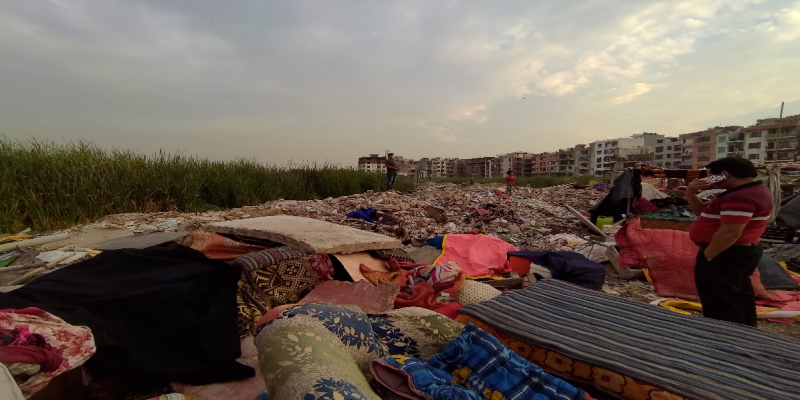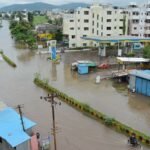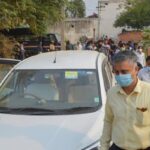New Delhi: A teenage girl was sitting on a broken table, cradling her sobbing younger sister. Both looked pale. Facing away, she indicated that she did not want to talk.
On September 24, her home was demolished.
As many as 100 bulldozed slum houses stripped the girl and many like her of privacy. To the correspondent, the girl seemed an extension of the wreckage surrounding her.
The Delhi Development Authority (DDA) cited the National Green Tribunal’s (NGT) law against construction on the river bank to demolish the slum at Dhobi Ghat on the Sailing Club Road, near Batla House’s Khalilullah Masjid.
“The law existed since time immemorial,” said Surender Chauhan, senior advocate at the Delhi high court.
“The dwellers get shelter from their leaders even if encroachment is taking place right under the nose of the government authorities, knowingly or unknowingly,” and the leaders, in turn, “get vote banks.”
“Indeed, during the elections, the leaders come to us and plead for votes,” said Shabana Khatoon, a resident of the slum, and, “now that they have been voted to power, they care only for the power.”
“The DDA had placed bollards to demarcate the land,” said a senior official of the DDA. The authority recently got to know that there is an encroachment on the Yamuna floodplain.”
“I cannot be 100% sure, but I can say that the slum was built during the pandemic,” said the official, seeking anonymity.
This is a claim the residents of the Dhobi ghat slum refute. “In fact, the authorities misused the pandemic to demolish the houses we built over the years,” they said.
The slum dwellers said that they had been around for at least two decades. “As buildings started cropping up, we were continuously pushed to the margins,” said Iqrar Husain, Shabana’s husband.

Photo of Dhobi Ghat slum demolished, near Batla House. Photo: Amir Malik
The Delhi Laws (Special Provision) Act, 2006 states that its provisions shall not apply on “any unauthorised construction started or continued on or after the 1st day of January, 2006, meaning that if the slum that existed prior to the said date is removed, the authorities must first rehabilitate.”
“This basic act should have been applied to the Batla House slum demolition as well,” said A. Dayyan, director of rehabilitation at the Delhi Urban Shelter Improvement Board (DUSIB).
Surender agreed. “The government has time and again flouted the policies that prohibit slum demolition without providing an alternative first,” he said.
“We were not given any notice,” said Rehana Khatoon, who comes from Lakhisarai, Bihar. “The authorities did not even give us a minute to get the Quran from our houses. I somehow managed to rescue the holy book.”
A quiet Dhobi Ghat is just a kilometre away from one of Delhi’s most noisy places, Batla House. But the fear that the remaining houses would be flattened soon was pervasive. “I feel like my heart has stopped beating,” said Rehana.
Slums are considered eyesores for cities. Hence, “in the garb of environmental protection, they initiate litigation without them being a party to the case. With favourable orders from the courts, they get slums demolished,” said Surendra.
Also read: ‘We’ll Be Back to Where We Started – on the Roads’: Fear Prevails as Delhi Slum Eviction Looms
Facts don’t lie
“The whole issue is about cleaning up the Yamuna,” said Salik Shafique, another senior lawyer at the Delhi high court.
At least 80% of Yamuna’s pollution load comes from untreated domestic sewage and only 10 to 20% come from industrial waste, Down To Earth reported, quoting the Delhi Jal Board.

A security guard watches over the demolished land in Dhobi Ghat, near Batla House. Photo: Amir Malik
“When NGT passes an order saying the DDA has to act, the DDA has to act in accordance with the law. It cannot simply go and start throwing things away. So, it is the DDA that has not followed due procedure,” added Salik.
The officials in the DDA and NGT would need to thus demolish all the houses and industries in and around the capital. But will this happen?
When it comes to taking action, the NGT has a polluted track record. It let Sri Sri Ravi Shankar’s Art of Living loose. His organisation AoL was found guilty of damaging the Yamuna floodplains by conducting the World Culture Festival on it.
An expert committee headed by Shashi Shekhar, then secretary, Ministry of Water Resources, said in a 47-page report that it would at least take a decade to restore the damages caused by AoL to the river’s natural vegetation.
“Not less than Rs 100 crore of damage was estimated by the committee constituted by NGT,” said Rahul Choudhary, environmental lawyer of the NGT and the Supreme Court. “It was a classic case of ‘pay and pollute’,” he added.
The demolished slum is off the Delhi-Noida link road, which takes one to Akshardham Mandir.
“The temple has been built on the floodplain of the river Yamuna,” Choudhary added.
Though its trust, the Bochasanwasi Shri Akshar Purushottam Swaminarayan Sanstha (BAPS), says that the Mandir has been built 1,700 meters away from the floodplain, this is not entirely true.
“If one builds a bund over the floodplain of a river for flood control, it does not necessarily mean that after embankments are ready, the floodplain of the river is reduced. However, Akshardham’s justification is that,” the advocate added.
Further, the construction of the temple’s extension building or its cultural complex started without environmental clearance. Its trust was fined 5% of the project cost as environmental compensation.
Later, NGT in a review application, took a contrary view regarding the penalty and allowed the construction. This decision of the NGT has been challenged and is pending before the Supreme Court.
Also read: The Death of Billo Rani’s Kids
The monstrous JCB
“It was like a monster ingurgitating everything that came its way,” said Rehana. The DDA official said, “We had to clear the area and the action was taken.”
Shagufta, a young child, said, “An aapi (sister) had a few kittens. When the bulldozers arrived, they were too young to come out on their own. She asked the policewoman to let her at least bring the kittens out. The woman in uniform refused. Aapi told her, ‘There will be a curse upon you’.”

Dhobi Ghat, near Batla House. Photo: Amir Malik
“The policewomen laughed and said, ‘So be it’. An hour later, a few kittens were found under the debris.
“This is like killing us. Killing the poor. What does the government achieve by pushing us to the brink?” said Shabana Begum.
Referring to Delhi chief minister Arvind Kejriwal’s statement that he was “son of Delhi”, she asked, “Where has ‘the son’ vanished when so many mothers are facing such hard times?”
“The police, much like the government, told us that our jhuggis could remain wherever they are. They lied and brought the bulldozers in,” said Iqrar.
Besides injuries on his head, Iqrar’s leg received a sharp cut when a bulldozer threw a small almirah his way. “Blood spilled all over,” he said. His green shirt is stained with the blood.
“What is it, if not a murder plan?” asked Shabana. “First, they destroyed toilets, second, stopped water supply, third, cut the electricity and then the huge JCBs had a taste of our houses.”
The Delhi Urban Shelter Improvement Board has reportedly been assigned the role of looking after the slum settlements. “Since it was the DDA that demolished the slum houses, DUSIB was unaware of the fact that this was being done,” DUSIB director Dayyan said.
Also read: The Right Time to Speak of Housing Rights in India Is Right Now
The cycle of poverty
During the day, Shabana raises bed sheets and sarees in the form of a tent. “The guards came and snatched them away.” For the night, the residents had collected money to bring in an electric wire and light a single bulb. “The guards threw Khabri Baba away,” she added.
“We are ordered to stop them from rehabilitating. It is our duty and we do it,” a guard had to say.
Since the lockdown, the women who work as domestic help have had no word. “The houses we were working in now avoid us out of fear of the coronavirus. It’s been seven months and I have earned no money,” Rehana said.
“Had life been easy in our village, we wouldn’t have come here. It was the devastation that brought us to Delhi and we are here, devastated yet again,” she added.
Shagufta’s notebook was found in the ruins, but she did not seem to care any more. “Ye mili copy (‘Found the notebook’),” she laughed. She put it back and walked away as a group of girls of her age followed her.
Umar Shareef who ran a tea-shop near the Ghat has slept atop the refrigerator in his shop since his house was razed.
As the call for evening prayers ring out from the mosques nearby, for the likes of Shabana and Rehana it is a reminder that poisonous snakes wander through the grounds where they sleep.
“We do not know whether we will see the next morning. Many times, we hear a hiss,” said Shabana.
The call to prayer stops. The teenage girl and her sister are not seen anywhere and a night falls on the residents of what used to be a slum.
Amir Malik is an independent journalist. He tweets at @_amirmalik.




